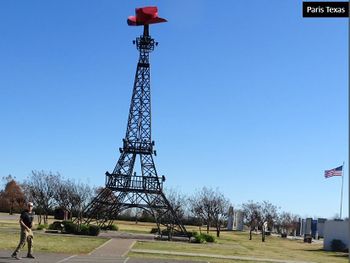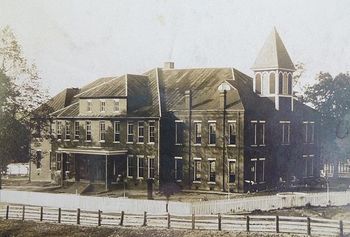Paris, Tennessee
Authors [about]:
join in to develop this article! |
Paris, TN (USA) is a small town in West Tennessee which was incorporated in 1823. As of 2010 (and for several decades past), its population hovers around 10,000 people. It is the county seat for Henry County and its town center, like many towns in the region, is built around an imposing court house which is now more than a hundred years old. The town is located in the upper right corner of West Tennessee, bordering with Kentucky to the north and the Tennessee River to the east. It is about two hours by car from any large city (Memphis to the SW, Nashville to the SW, or Paducah, KY to the north). Even the nearest medium size city (Jackson, TN) is over an hour's drive distant. Nearby small towns are Camden, TN (45 minutes by car to the SE) and Murray, KY (45 minutes to the north).
Replica of the Eiffel Tower: 1990's
In 1993, both Paris, TN and Paris, TX decided to build Eiffel Towers, each 60 feet high. But when the towers were deployed, the people of Paris, TN, had sneaked an extra 10 feet onto their tower, making it the tallest Eiffel tower in the USA. The people of Paris, TX, feeling perhaps uncharacteristically belittled, found it necessary to escalate the towers arms race by adding a highly provocative red Stetson hat to their tower. That decision turned out to be controversial, as some people in the state of Texas described it as the stupidest decision ever made, even for the state of Texas.
Integration of the schools: 1960's
Although Paris, TN was the only incorporated town in the county, several smaller communities nearby, up until 1970, had their own schools, including Henry (W), Cottage Grove (N), and Springville (E). Paris itself had multiple elementary, junior high, and high schools. The population of the area in the 1960's was about 15% African American, and schools in Paris were segregated[1]. Around 1963, facing the Supreme Court mandate to end racial school segregation, the Henry County school system began a gradual introduction of African American students into formerly all-white elementary schools in Paris, paralleling similar actions taken all over the South.
Consolidating all students into the geographic middle
In the early 1960's, Henry County Schools also began building a consolidated high school in the town which would become only high school in the county and, being located in the county center, would serve all students regardless of race. This school, Henry County High School, opened in 1970 with an innovative, round-building design[2]. Smaller high schools in outlying communities had to close and bus their students to the consolidated school. The outlying elementary schools closed in favor of larger elementary and junior high schools in Paris. By these actions, the Henry County School system finally became racially integrated, with less overt conflict than some surrounding areas in the region.
School renamed in 2020 to avoid commemorating civil war
On the outskirts of Paris, TN stands an old school building, abandoned in the 1970's due to consolidation--and it had long been named for the confederate Civil War general Robert E. Lee. In 1861, confederate troops were mustered on the school grounds and in the old building. In 1988, the current building (dating from 1881) was added to the National Trust Register of Historic Places, and in the early 2000's, a non-profit was formed to convert the then-vacant building into "Lee Academy for the Arts". At the start of the 2020-21 school year, with race relations again in the limelight, the school's non-profit board renamed the historic Robert E. Lee School to the Paris Academy for the Arts[3]. The charter school offers year-round classes and workshops with an emphasis on visual and performing arts.
- ↑ Like all, or most, communities in the South, neighborhoods were also segregated, with African Americans predominantly relegated to live in one small portion of the town. It would be interesting to know how much the segregation of housing has changed, if any, since the 1960's.
- ↑ Three round buildings were built, with classrooms around the outsides and common areas (auditorium, library, cafeteria) in the middle.
- ↑ https://www.schoolforarts.org/buildinghistory, last access 9/4/2020


